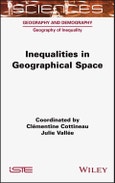Inequalities are central to the public debate and social science research. They are inextricably linked to geographical space, shaping human mobility and migration patterns, creating diverse living environments and changing individuals’ perceptions of the society they live in and the inequalities that endure within it. Geographical space contributes to the emergence and perpetuation of inequalities between individuals according to their socioeconomic position, gender, ethno-racial origin or even their age.
Inequalities in Geographical Space examines inequalities in education, in the workplace, in public and private spaces and those related to migration. Written by geographers, sociologists and economists, this book draws on a variety of theoretical and methodological approaches and compares different spatial and temporal scales. It highlights the importance of geographical space as a vehicle for the expression, creation and reproduction of social, racial, economic and gender inequalities.
Table of Contents
Introduction xi
Clémentine COTTINEAU and Julie VALLÉE
Chapter 1 The Spatial Dimension of Educational Inequalities 1
Leïla FROUILLOU
1.1 Introduction 1
1.2 School segregation as the central object of socio-geographical approaches to school inequalities 5
1.3 The spatial dimension of educational inequalities: from policies to trajectories 11
1.4 Conclusion: spatial dimension of inequalities and the interweaving of levels of analysis 19
1.5 References 20
Chapter 2 Socio-spatial Inequalities and Intersectionality 27
Negar Élodie BEHZADI and Lucia DIRENBERGER
2.1 Relationships between power relations, inequalities and space 28
2.2 Work and socio-spatial inequalities 33
2.3 Othering processes and spaces: the place of the other 40
2.4 Agency and minority spaces 45
2.5 Conclusion 49
2.6 References 51
Chapter 3 Migration, Multi-situated Inequalities and the World Economy 61
Laurence ROULLEAU-BERGER
3.1 Toward a sociology of inequalities and migrations 62
3.2 International cities and migrant workers 66
3.3 Multi-situated inequalities and biographical bifurcations 70
3.4 Moral careers and the struggle for recognition 72
3.5 The plurality and hierarchy of transnationalisms 74
3.6 Forced migration, downgrading and expulsions 78
3.7 Conclusion 80
3.8 References 80
Chapter 4 The Geographical Dimension of Inequalities in Access to Employment 85
Philippe ASKENAZY and Verónica ESCUDERO
4.1 Introduction 85
4.2 Compensatory differences between territories 89
4.3 Immobility and spatial mismatch 91
4.4 The importance of couples' geographic trade-offs in individuals' access to employment 97
4.5 Labor market networks and access to employment 102
4.6 Digital space: the abolition of geographical constraints? 104
4.7 Conclusion 111
4.8 References 113
Chapter 5 The Perception of Inequality and Poverty in the Most Segregated, Affluent Neighborhoods 119
Serge PAUGAM
5.1 Studying the perception of poverty 122
5.2 The constitution of a moral boundary 127
5.3 Keeping out the working class 130
5.4 Justifying class inequality and poverty 136
5.5 Conclusion 143
5.6 References 146
Chapter 6 Modeling Inequalities in Geographical Space 151
Clémentine COTTINEAU
6.1 Introduction: different modeling formalisms for different purposes 151
6.2 Inequality in the distribution of economic resources and in its spatial distribution 152
6.3 Statistical regression models: estimating the effects of geographic location on inequality 160
6.4 Simulation models to explain and illustrate the dynamics of inequalities in geographical space 169
6.5 Conclusion 176
6.6 References 177
Chapter 7 A Critical Reading of Neighborhood-based Policies and their Geography 183
Julie VALLÉE
7.1 A geography plagued by contradictions 184
7.2 Reductive policies 190
7.3 Temporal dynamics of priority neighborhoods 194
7.4 Conclusion 205
7.5 References 206
List of Authors 211
Index 213








